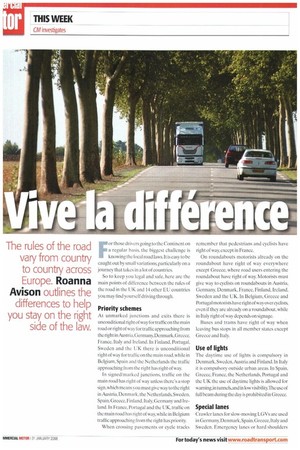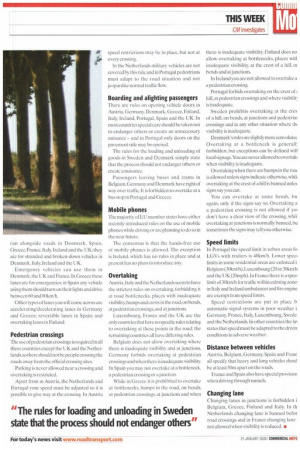The rules of the road vary from country to country across
Page 20

Page 21

If you've noticed an error in this article please click here to report it so we can fix it.
Europe. Roanna Avison outlines the
differences to help you stay on the right side of the law.
For those drivers going to the Continent on a regular basis, the biggest challenge is knowing the local road laws, It is easy to be caught out by small variations, particularly on a journey that takes in a lot of countries.
So to keep you legal and safe, here are the main points of difference between the rules of the road in the UK and 14 other EU countries you may find yourself driving through.
Priority schemes
At unmarked junctions and exits there is unconditional right of way for traffic on the main road or right of way for traffic approaching from the right in Austria,Germany, Denmark, Greece, France, Italy and Ireland. In Finland, Portugal, Sweden and the UK there is unconditional right of way for traffic on the main road, while in Belgium, Spain and the Netherlands the traffic approaching from the right has right of way.
In signed/marked junctions, traffic on the main road has right of way unless there's a stop sign,which means you must give way to the right in Austria, Denmark, the Netherlands, Sweden, Spain, Greece, Finland, Italy, Gemany and Ireland. In France, Portugal and the UK, traffic on the main road has right of way, while in Belgium traffic approaching from the right has priority.
When crossing pavements or cycle tracks remember that pedestrians and cyclists have right of way, except in France.
On roundabouts motorists already on the roundabout have right of way everywhere except Greece, where road users entering the roundabout have right of way. Motorists must give way to cyclists on roundabouts in Austria, Germany, Denmark, France, Finland, Ireland, Sweden and the UK. In Belgium, Greece and Portugal motorists have right of way over cyclists, even if they arc already on a roundabout, while in Italy right of way depends on signage.
Buses and trams have right of way when leaving bus stops in all member states except Greece and Italy.
Use of lights
The daytime use of lights is compulsory in Denmark, Sweden, Austria and Finland. In Italy it is compulsory outside urban areas. In Spain, Greece, France, the Netherlands, Portugal and the UK the use of daytime lights is allowed for warning,in tunnels, and in low visibility:File use of full beam during the day is prohibited in Greece.
Special lanes
Crawler lanes for slow-moving LGVs are used in Germany Denmark,Spain.Greece, Italy and Sweden. Emergency lanes or hard shoulders run alongside roads in Denmark, Spain, Greece, France, Italy, Ireland and the UK; they are for stranded and broken-down vehicles in Denmark, Italy, Ireland and the UK.
Emergency vehicles can use them in Denmark, the UK and France. In Greece these lanes are for emergencies; in Spain any vehicle using them should turn on their lights and drive between 60 and 80km/h.
Other types of lanes you will come across are accelerating/decelerating lanes in Germany and Greece; reversible lanes in Spain; and overtaking lanes in Finland.
Pedestrian crossings
The use of pedestrian crossings is required in all these countries except the UK and the Netherlands,so there should not be people crossing the roads away from the official crossing sites.
Parking is never allowed near a crossing and overtaking is restricted.
Apart from in Austria, the Netherlands and Portugal your speed must be adjusted so it is possible to give way at the crossing. In Austria speed restrictions may be in place, but not at every crossing.
In the Netherlands military vehicles are not covered by this rule and in Portugal pedestrians must adapt to the road situation and not jeopardise normal traffic flow.
Boarding and alighting passengers
There are rules on opening vehicle doors in Austria, Germany, Denmark, Greece, Finland, Italy, Ireland, Portugal. Spain and the UK. In most countries special care should be taken not to endanger others or create an unnecessary nuisance — and in Portugal only doors on the pavement side may be opened.
The rules for the loading and unloading of goods in Sweden and Denmark simply state that the process should not endanger others or create a nuisance.
Passengers leaving buses and trams in Belgium,Germany and Denmark have right of way over traffic. It is forbidden to overtake at a bus stop in Portugal and Greece.
Mobile phones
The majority of EU member states have either recently introduced rules on the use of mobile phones while driving or are planning to do so in the near future.
The consensus is that the hands-free use of mobile phones is allowed. The exception is Ireland. which has no rules in place and at present has no plans to introduce any.
Overtaking
Austria, Italy and the Netherlands seem to have the strictest rules on overtaking, forbidding it at road bottlenecks, places with inadequate visibility, humps and crests in the road, on bends, at pedestrian crossings, and at junctions.
Luxembourg. France and the UK are the only countries that have no specific rules relating to overtaking at these points in the road; the remaining countries all have differing rules.
Belgium does not allow overtaking where there is inadequate visibility and at junctions. Germany forbids overtaking at pedestrian crossings and when there is inadequate visibility, In Spain you may not overtake at a bottleneck, a pedestrian crossing or a junction.
While in Greece it i.s prohibited to overtake at bottlenecks, humps in the road, on bends, at pedestrian crossings, at junctions and when there is inadequate visibility. Finland does no allow overtaking at bottlenecks, places witl inadequate visibility, at the crest of a hill. 01 bends and at junctions.
In Ireland you are not allowed to overtake a a pedestrian crossing.
Portugal forbids overtaking on the crest of ; hill, at pedestrian crossings and where visibilit, is inadequate.
Sweden prohibits overtaking at the cres of a hill, on bends, at junctions and pedestriai crossings and in any other situation where thi visibility is inadequate.
Denmark's rules are slightly more convolutec Overtaking at a bottleneck is generall: forbidden, but exceptions can be defined witl local signage.You are never allowed to overtaki when visibility is inadequate.
Overtaking when there are humps in the rom is allowed unless signs indicate otherwise, whil, overtaking at the crest of a hill is banned unles signs say you can.
You can overtake at some bends, bu again, only if the signs say so. Overtaking a a pedestrian crossing i.s not allowed if yoi don't have a clear view of the crossing, whil, overtaking at junctions is normally banned, bu sometimes the signs may tell you otherwise.
Speed limits
In Portugal the speed limit in urban areas fo LG Vs with trailers is 40km/h. Lower spec, limits in some residential areas are enforced i: Belgium (30km/h),Luxembourg (20 or 30kmili and the UK (20mph). In France there is a spee, limit of 30krniti for traffic within calming zone: in Italy and Ireland ambulances and fire engine are exempt from speed limits.
Speed restrictions are put in place b autotnatic signal systems in poor weather i Germany, France, Italy, Luxembourg, Swede and the Netherlands. In other countries the laN states that speed must be adapted to the drivin conditions in adverse weather.
Distance between vehicles
Austria, Belgium, Germany, Spain and Franc all specify that heavy and long vehicles shoul heat least 50m apart on the roads.
France and Spain also have special provisior when driving through tunnels.
Changing lane
Changing lanes in junctions is forbidden i Belgium, Greece, Finland and Italy. In th Netherlands changing lane is banned befor road crossings and in France changing lane not allowed when visibility is reduced. tr
































































































































































